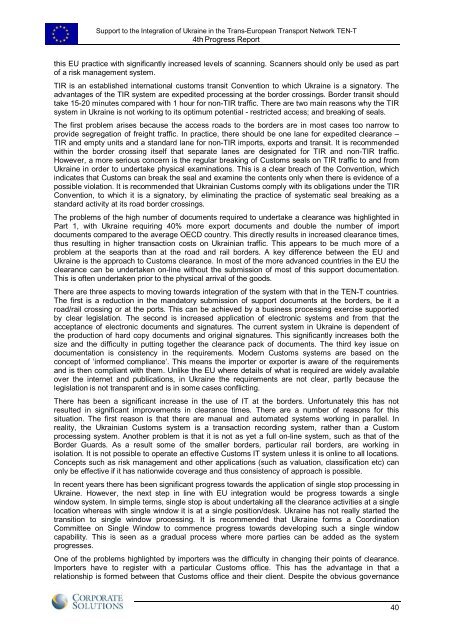Progress Report 4
Progress Report 4
Progress Report 4
Create successful ePaper yourself
Turn your PDF publications into a flip-book with our unique Google optimized e-Paper software.
Support to the Integration of Ukraine in the Trans-European Transport Network TEN-T<br />
4th <strong>Progress</strong> <strong>Report</strong><br />
this EU practice with significantly increased levels of scanning. Scanners should only be used as part<br />
of a risk management system.<br />
TIR is an established international customs transit Convention to which Ukraine is a signatory. The<br />
advantages of the TIR system are expedited processing at the border crossings. Border transit should<br />
take 15-20 minutes compared with 1 hour for non-TIR traffic. There are two main reasons why the TIR<br />
system in Ukraine is not working to its optimum potential - restricted access; and breaking of seals.<br />
The first problem arises because the access roads to the borders are in most cases too narrow to<br />
provide segregation of freight traffic. In practice, there should be one lane for expedited clearance –<br />
TIR and empty units and a standard lane for non-TIR imports, exports and transit. It is recommended<br />
within the border crossing itself that separate lanes are designated for TIR and non-TIR traffic.<br />
However, a more serious concern is the regular breaking of Customs seals on TIR traffic to and from<br />
Ukraine in order to undertake physical examinations. This is a clear breach of the Convention, which<br />
indicates that Customs can break the seal and examine the contents only when there is evidence of a<br />
possible violation. It is recommended that Ukrainian Customs comply with its obligations under the TIR<br />
Convention, to which it is a signatory, by eliminating the practice of systematic seal breaking as a<br />
standard activity at its road border crossings.<br />
The problems of the high number of documents required to undertake a clearance was highlighted in<br />
Part 1, with Ukraine requiring 40% more export documents and double the number of import<br />
documents compared to the average OECD country. This directly results in increased clearance times,<br />
thus resulting in higher transaction costs on Ukrainian traffic. This appears to be much more of a<br />
problem at the seaports than at the road and rail borders. A key difference between the EU and<br />
Ukraine is the approach to Customs clearance. In most of the more advanced countries in the EU the<br />
clearance can be undertaken on-line without the submission of most of this support documentation.<br />
This is often undertaken prior to the physical arrival of the goods.<br />
There are three aspects to moving towards integration of the system with that in the TEN-T countries.<br />
The first is a reduction in the mandatory submission of support documents at the borders, be it a<br />
road/rail crossing or at the ports. This can be achieved by a business processing exercise supported<br />
by clear legislation. The second is increased application of electronic systems and from that the<br />
acceptance of electronic documents and signatures. The current system in Ukraine is dependent of<br />
the production of hard copy documents and original signatures. This significantly increases both the<br />
size and the difficulty in putting together the clearance pack of documents. The third key issue on<br />
documentation is consistency in the requirements. Modern Customs systems are based on the<br />
concept of ‘informed compliance’. This means the importer or exporter is aware of the requirements<br />
and is then compliant with them. Unlike the EU where details of what is required are widely available<br />
over the internet and publications, in Ukraine the requirements are not clear, partly because the<br />
legislation is not transparent and is in some cases conflicting.<br />
There has been a significant increase in the use of IT at the borders. Unfortunately this has not<br />
resulted in significant improvements in clearance times. There are a number of reasons for this<br />
situation. The first reason is that there are manual and automated systems working in parallel. In<br />
reality, the Ukrainian Customs system is a transaction recording system, rather than a Custom<br />
processing system. Another problem is that it is not as yet a full on-line system, such as that of the<br />
Border Guards. As a result some of the smaller borders, particular rail borders, are working in<br />
isolation. It is not possible to operate an effective Customs IT system unless it is online to all locations.<br />
Concepts such as risk management and other applications (such as valuation, classification etc) can<br />
only be effective if it has nationwide coverage and thus consistency of approach is possible.<br />
In recent years there has been significant progress towards the application of single stop processing in<br />
Ukraine. However, the next step in line with EU integration would be progress towards a single<br />
window system. In simple terms, single stop is about undertaking all the clearance activities at a single<br />
location whereas with single window it is at a single position/desk. Ukraine has not really started the<br />
transition to single window processing. It is recommended that Ukraine forms a Coordination<br />
Committee on Single Window to commence progress towards developing such a single window<br />
capability. This is seen as a gradual process where more parties can be added as the system<br />
progresses.<br />
One of the problems highlighted by importers was the difficulty in changing their points of clearance.<br />
Importers have to register with a particular Customs office. This has the advantage in that a<br />
relationship is formed between that Customs office and their client. Despite the obvious governance<br />
40


